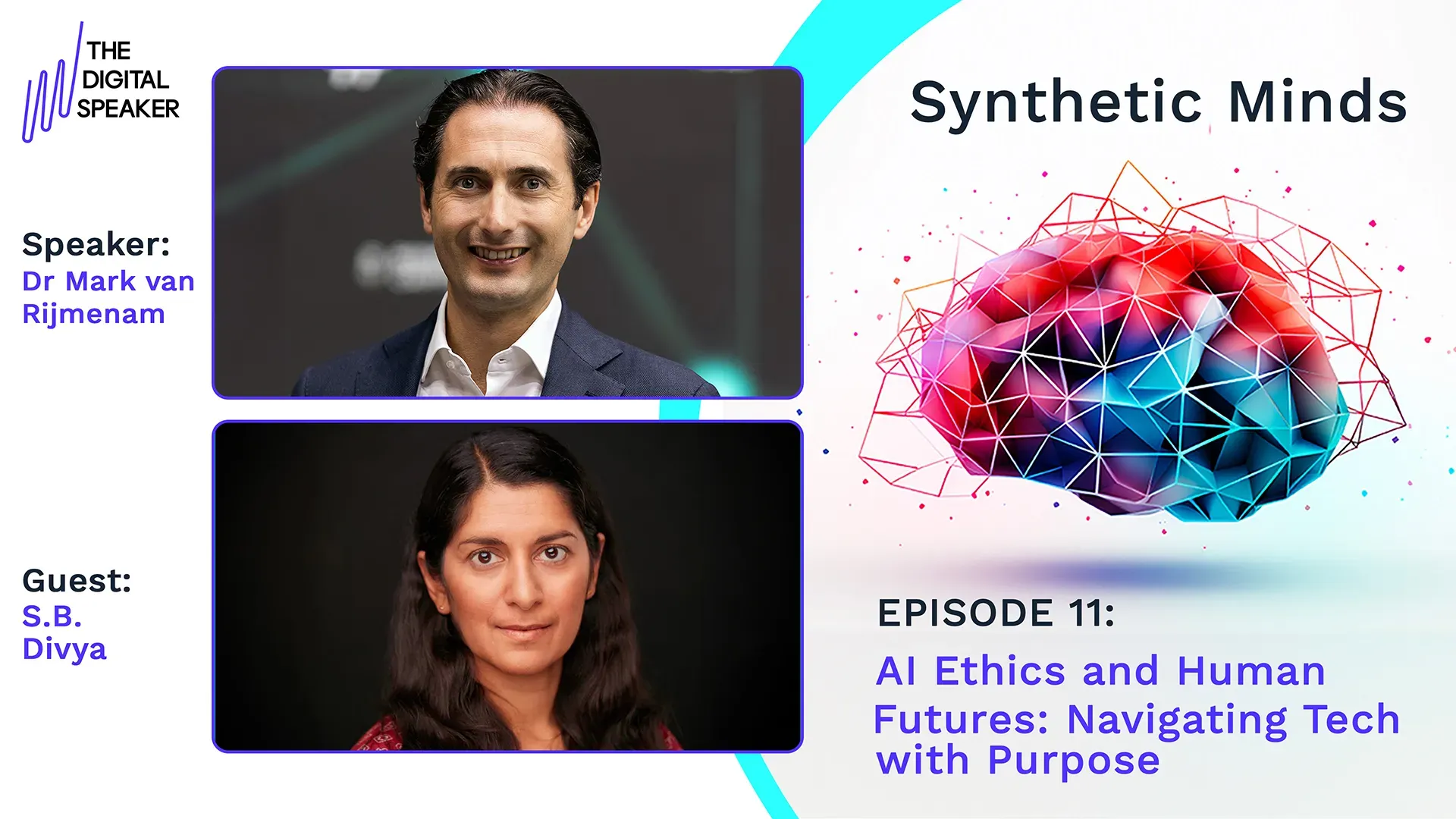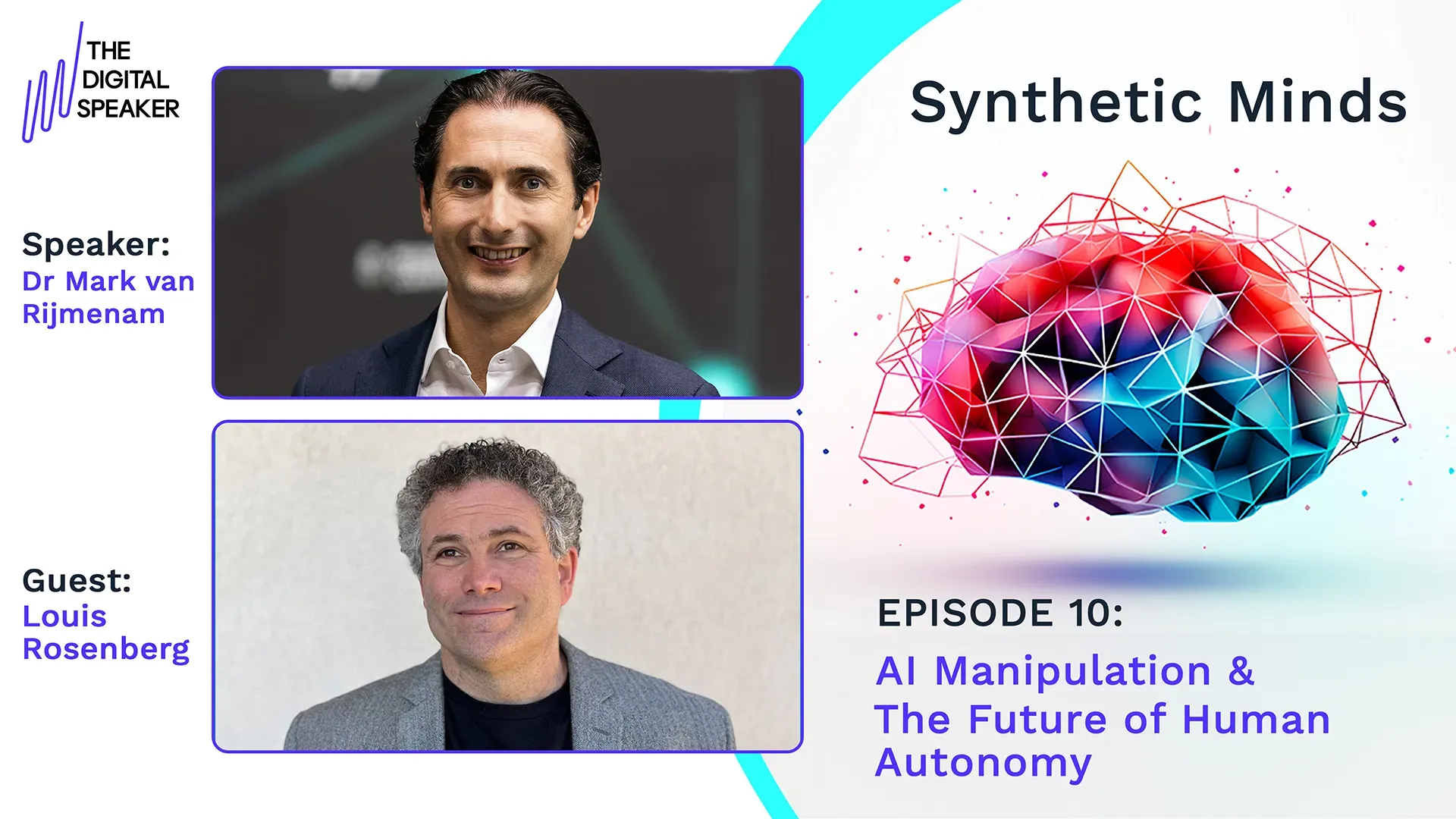The Digital Speaker series: The Tech Journal - EP06 - Algorithmic Management

What do you get when you cross Elon Musk with Jeff Bezos? Algorithmic Management…
Hello netizens! Welcome to the Tech Journal. My name is Mark van Rijmenam, and I am The Digital Speaker.
In these journals, I project my digital twin into cyberspace, bringing you the latest-and-greatest of the digital world from inside the digital world. I cover all the latest digital news, from algorithms and crypto through to GPT-4 and neural networks.
Today, I am going to take you on an algorithmic journey. Together, we will delve into and explore the complex world of Algorithmic Management. Taking a closer look at the pros, cons, and future of this style of management.
Sit back, relax, and let us start speaking digital.
You can either view the episode above or view it on Vimeo, YouTube or listen to it on Anchor.fm, Soundcloud or Spotify. Below is the transcript of the video if you prefer to read the episode.
____________________________________
Algorithmic Management
Now, with the explosion of the “gig economy”, we stand witness to a process which in the space of two decades, has revolutionised the way that millions of people work.
Advocates of this revolution like to argue that the gig economy creates more opportunities and lowers labour market entry barriers.
Critics say that it erodes workplace regulations, lowers working standards, and increasingly encourages businesses to treat workers as disposable. No matter which side of the debate you fall on, the gig economy is here to stay.
But with more and more people making the decision to go freelance or opt-in for flexible hours, how are businesses keeping up?
Enter “algorithmic management”, the use of algorithms to oversee the efforts of human staff. As this becomes more commonplace, it is important to understand what it is, how it helps, how it hurts, what the future holds, and how it will affect you personally.
First, let us get the obvious out the way; what is algorithmic management?
Algorithmic management, as the name suggests, is using algorithms to manage a team of human workers. As ever more advanced AI techniques are used to create increasingly intelligent algorithms, human managers are simply being outperformed at each-and-every turn.
These managerial algorithms are designed to collect huge swathes of metadata on employee performance. Once analysed, this data is used to increase efficiency.
While the human mind is capable of this, the difference is the same as streaming compared to a VHS; both let you watch movies, but one is significantly better at it.
Using this data, algorithms automate large portions of the managerial decision-making process, relegating humans to a more overarching ceremonial role.
While it is tough to estimate just how prevalent algorithmic management is, we can make some educated guesses based on available data. For example, 40 per cent of human resources departments in international companies are reported to be using Algorithms. But in what respect are these algorithms being used? Let us take a closer look.
Examples of Algorithmic Management
Amazon’s warehouse in Melbourne, Australia, uses algorithms to manage its employees. These algorithms decide which items need to be picked, moved, stored, and shipped. They also monitor how fast employees work, how many bathroom breaks they take, and general performance metadata. As you would expect, problems are already rearing their ugly heads.
Employees report feeling spied on and constantly pressured to go faster and improve their “pick rate”, a metric measuring how fast they retrieve items. Workers with low pick rates are increasingly more likely to lose their job. There have also been whispers of employees being reprimanded for spending “too long” in the bathroom.
Another company to adopt algorithmic management is HireVue, a video interviewing software platform. They have begun experimenting with a facial analysis AI, which assesses people in interview settings. The AI analyses facial expressions, tone of voice, use of language, and other aspects, all in real-time.
HireVue argued that the new system can speed up the hiring process up to a massive 90 per cent, while critics have pointed out it reinforces existing social discrimination.
This isn’t the first time an algorithm has had that problem though, but I’ll touch on that later.
Another example can be found in popular food take out service, Deliveroo. This company uses algorithms to monitor delivery driver performance. This data is then transferred into a personalised monthly report.
The report breaks down a driver’s average time to accept orders, average travel time to restaurants and customers, and the number of late and unassigned orders. This data reportedly helps the company set targets, while also giving drivers an opportunity to make more money.
Having said that, drivers have reported feeling that they are under constant surveillance, which according to workplace surveillance studies, can have an extreme negative impact on performance. However, the effect of surveillance on freelance work is unprecedented, so we will have to watch it evolve in real-time.
These are only just a few examples of the many ways companies are starting to utilize algorithms. But examples aside, let us take a closer look at the pros and cons of algorithmic management?
The pros and cons of algorithmic management
As I’m an optimist, let us start with the positives.
Fans of algorithmic management like to claim that the practice opens new opportunities for both companies and employees alike.
One of the main positives is that it lowers costs by offloading managerial tasks to computers. For example, a job that might take humans hours can be completed within seconds by a powerful algorithm. By significantly lowering an organisation’s labour costs, shareholders and stakeholders alike will find it attractive, not to mention the potential for savings to be passed onto consumers.
Another pro algorithm fans like to point out are how efficient they are. When algorithmic management is used to schedule shifts, or allocate tasks, they significantly reduce wasted time for both managers and employees.
This then in turn ties into the first positive and ends up saving money and leads into another pro, their ability to help make better business decisions.
You see, since algorithms make data-driven decisions, theoretically their decisions are totally objective. They don’t rely on intuition, gut feelings, or social pressures. Ideally, this objectivity should help reduce bias, removing, or at least reducing, favouritism and cronyism.
Which seamlessly leads me onto the cons. Objectivity relies on the algorithm not being programmed with the creator’s bias, something that has unfortunately happened multiple times throughout the world.
Back in 2019, for example, an algorithmic management system in an American hospital was found to be making decisions that lead to African American patients receiving a lower quality of care.
Another example happened in 2020, when another algorithmic management system, this time used by the British Ministry of Education, was found to be attributing exam results according to the student’s social class. Giving lower-class students lower grades, regardless of their educational record.
While the algorithms were not behaving as expected in these circumstances, there are times where algorithms working as they should have ended up being destructive.
3 Complaints of Algorithmic Management
A 2019 study of Uber drivers in New York and London found that many drivers did not appreciate having an algorithm manage them. Their complaints could be broken down into three categories: surveillance, transparency, and dehumanization.
1. Surveillance
The first, surveillance, as I briefly mentioned before with Deliveroo drivers, can be broken down to the idea that Uber drivers, and by that matter most workers, hate being spied on. In a bid to increase productivity, Uber employed algorithmic management to keep an eye on drivers.
The algorithm kept track of various performance indicators, such as speed, location, and acceptance rates. Doing something the algorithm perceived as “wrong”, could lead to penalties or even a permanent ban from the platform. On one hand, Uber’s desire to collect as much data as possible makes total sense.
Since the Uber business model lacks human managers, they needed a system to help keep track of their operators. Still, as well-intentioned their move was, monitoring employees to improve productivity has been proven to backfire. Studies have shown that constant surveillance encourages less engagement, lower morale, and breeds distrust.
An example of a company taking this study onboard can be seen back in February 2020. Barclays scrapped plans to install tracking software intended to monitor employee work and movements. While the company supported the idea, the disdainfully dubbed “spyware”, caused a huge backlash from their staff and others in the financial industry.
2. Lack of transparency
The second category, lack of transparency, can be broken down to how Uber drivers recognised a power imbalance between the company and them. While drivers complained about how they were kept in the dark about how the algorithm worked, Uber tried to argue that it could not reveal too much about their algorithm.
The company claimed if they educated their drivers, the drivers would simply play the system, and more, that the app’s inner workings were a trade secret, and could have disastrous ramifications if it were to get out. Further, with the algorithm being so complex, constantly adjusting to new conditions, it is claimed that even an expert can find it difficult to explain what is going on, let alone a driver.
Regardless of how valid these excuses may be, it does not change the fact that algorithmic management is frustratingly cryptic to drivers. Since the human brain hates ambiguity, the lack of information causes drivers to feel slighted or rejected. According to one psychological study, feeling “out of the loop” causes employees to feel 58 per cent less important.
3. Feelings of dehumanisation
Then the third, and arguably the worst category, feelings of dehumanization.
Since most Uber drivers spend a lot of time alone with the app and passengers, they do not get the opportunity to build relationships with human supervisors or colleagues. This lack of human feedback makes it difficult for drivers to understand how they are performing, and more, to feel that they are doing meaningful work.
With the idea of meaningful work being a cornerstone to human happiness and workplace satisfaction. The Uber app takes dehumanization further, by employing various behavioural techniques to “nudge” drivers in a particular direction.
The New York Times documented this well in their article, “How Uber Uses Psychological Tricks to Push Its Drivers’ Buttons”. One of these manipulative techniques sends a driver a message when they are about to exit the app, highlighting how much more money they need to make before they hit a target.
Messages like, “You’re $10 away from making $330 in net earnings. Are you sure you want to go offline?”, are commonplace.
While this Uber case study is particularly extreme, the sensation of dehumanisation will only grow as algorithmic management spreads and workers are increasingly treated like numbers. This paints a picture of a future workplace where employers risk alienating their employees.
The future of algorithmic management
So, what does all this mean then? What does the future of algorithmic management look like? Well, since the future is looking more and more like a safe place for AI, neural networks, and algorithms, it is safe to say algorithmic management is not going anywhere.
Hopefully, being the digital optimist that I am, with more time and experience, algorithm processes will get less intrusive, and more, dare I say it, human. To get there, there are a few ground rules which will need to be established.
- Staff feedback will need to take centre stage. Since algorithmic management is hated due to its total lack of communication, inviting staff to give feedback is essential. Giving them an opportunity to participate in the decision-making process can help boost engagement, morale, and even improve the algorithm itself.
- Worker welfare needs to be addressed. Companies using algorithmic management need to work towards improving worker conditions, taking steps to show their commitment to the welfare of their staff. If this is done right, a company can create employees who feel valued, and not just like another digital brick in the wall.
- Companies need to increase their human touch. Even where workers are directly managed by an algorithm, keeping human managers and assistance roles will foster human connections, increasing staff satisfaction. Uber already is trying to do this and now offers in-app phone support for drivers.
If organisations are able to get through these challenges and create an environment where both human staff and algorithm management can peacefully co-exist, we could be looking at the beginning of a prosperous human-machine relationship.
To get there, organisations are going to need to ask themselves some hard questions. Questions like:
- What role do human managers have in the age of algorithmic management?
- Will human managers and algorithm managers collaborate well or come into conflict?
- Can and will workers push back against algorithmic management?
- How much transparency will organisations give to algorithmic management?
- How do you balance the need for increased data collection with a worker’s right to privacy?
The answers to all these questions are still uncertain, but one thing is for sure, humans as a species will answer them, for answering the unanswerable is intrinsically human.
And on that digital note, if you are still watching, both humans and AIs, please leave a like, subscribe to the channel, and click that bell. It is what the algorithm wants. My name is Mark van Rijmenam, and I am The Digital Speaker.
See you next time for your digital download.
Stay digital.





























